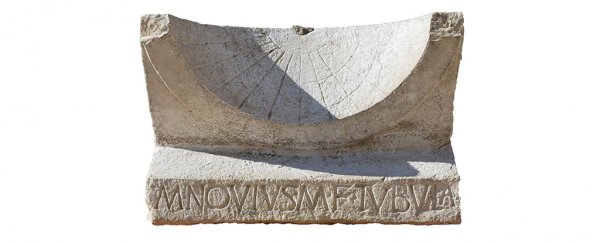Archaeologists in central Italy have dug up a truly remarkable sundial. The inscription on the ancient slab of limestone is so well preserved, we know the name of the man who once paid for it.
And, judging from that information, it looks like the timepiece was a politician's gift to the plain, mediocre hometown from which he hailed to become an elected official in Rome. Not a bad career move.
The sundial, a concave half-bowl lined with marks to indicate hours and seasons, was unearthed by students working on the excavation site of a roofed theatre in what was once the town of Interamna Lirenas.
These days the settlement site in central Italy is almost completely obscured by farmland, although archaeologists from the University of Cambridge have been milling about those fields since 2010 as part of a research programme investigating the transformation of the once-great Roman Empire.
Interamna Lirenas, founded in the late 4th century BCE, was once thought to be a dwindling, unimportant colony, although the finding of a roofed theatre that could seat some 1,500 people has since changed that perception.
Still, it wasn't a massively important or prestigious place by any means, according to the researchers who've been digging around there for years.
But this fact actually makes the sundial's discovery all the more fascinating.
On its base, an engraving clearly states the name of one "Marcus Novius Tubula, son of Marcus", and reading the rim of the curved dial we learn he was a Plebeian Tribune (an elected official in Rome) and he paid for the sundial with his own money.
According to the team, the last name 'Tubula' indicates this guy hailed from Interamna Lirenas itself, since it's the only place where this particular cognomen - a type of Roman last name - has been recorded.
From the style of the inscription, researchers have been able to date the sundial back to around the middle of the 1st century BCE, at which time the townsfolk would have been granted full Roman citizenship.
Which means that Marcus Novius Tubula had been elected as a powerful politician even though he hailed from a small country town.
"The sundial would have represented his way of celebrating his election in his own hometown," says classicist Alessandro Launaro from the University of Cambridge.
Whenever someone checked the time using the sundial, likely displayed on top of a pillar near the theatre, they'd remember that their fellow townsman had made it big in Rome.
Even though this type of sundial was quite common in the Roman period, less than one hundred of them have survived to our day, and only a handful of those had any legible inscriptions, hence this specimen "really is a special find", according to Launaro.
And the link between the middle-sized settlement and an elected Roman official gives us a new understanding of the relationship between small towns and the capital of the ancient power.
If someone like Marcus Novius could become involved in the political affairs in Rome, it shows that even people from fairly unimportant communities could aspire to great things.
"In this sense, the discovery of the inscribed sundial not only casts new light on the place Interamna Lirenas occupied within a broader network of political relationships across Roman Italy, but it is also a more general indicator of the level of involvement in Rome's own affairs that individuals hailing from this and other relatively secondary communities could aspire to," explains Launaro.
The sundial's discovery was announced through a press release from the University of Cambridge.
